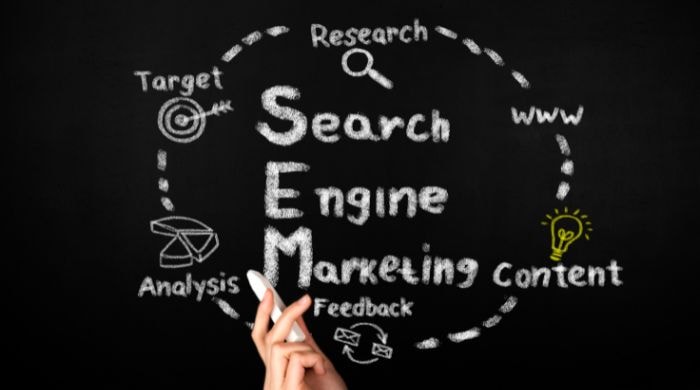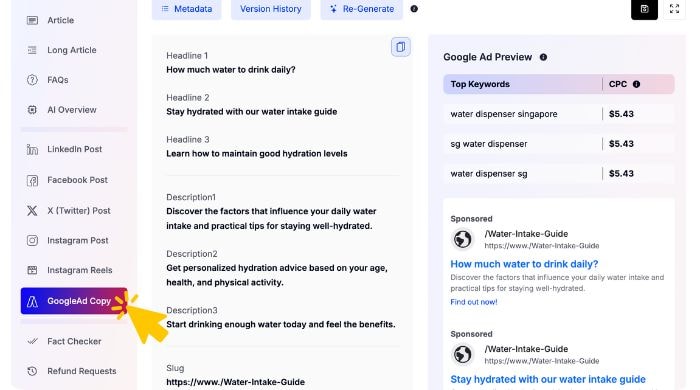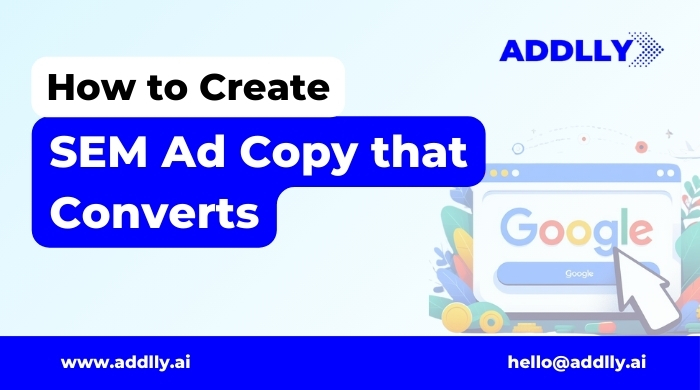Search Engine Marketing (SEM) is a powerful tool that helps businesses gain visibility on search engine results pages (SERPs) when potential customers search for relevant keywords. However, achieving visibility alone isn’t enough—creating SEM ad copy that converts your target audience and prompts them to take action is key.
The success of your ad campaigns relies on crafting engaging SEM text ads that not only attract attention but also lead users to optimized landing pages. In this article, we’ll explore proven strategies for writing high-performing SEM ad copy that boosts clicks, conversions, and delivers impressive results for your business.
Quick Summary Powered by Addlly AI
ToggleWhat is SEM Ad Copy and Why It Matters
SEM ad copy refers to the text used in paid advertisements that appear on SERPs. Unlike organic results, SEM ads are paid placements designed to drive immediate traffic and conversions for targeted searches. The key to a successful SEM campaign lies in writing ad copy that is compelling, persuasive, and targeted at the right audience.
A great SEM ad has several key aspects, including:
- Relevance: The ad copy must reflect the search intent of potential customers, utilizing relevant keywords to match what they are searching for.
- Unique Selling Proposition (USP): Highlighting a unique selling proposition sets your ad apart from competitor ads and shows users why your product or service is superior.
- Persuasive Language: The best ad copy uses compelling and benefit-oriented language to evoke emotion and prompt action.
Key Elements of SEM Ad Copy
- Headline: The headline is the first element users notice and plays a vital role in attracting clicks. Focus on crafting a clear, compelling headline with relevant keywords to match user intent and enhance visibility.Description: This section expands on the product or service being advertised. Provide concise, persuasive information that highlights unique benefits and aligns with the landing page content for relevance.Call-to-Action (CTA): A strong CTA prompts immediate action, such as “Learn More” or “Get Your Free Demo.” Ensure it supports campaign goals and drives conversions.Display URL: The display URL shows users where they’ll land upon clicking. Make it concise, keyword-rich, and aligned with your SEM strategy to build trust and improve performance.Extensions: Ad extensions, like site links, increase ad visibility by adding relevant links, contact details, or promotions. Use them strategically to enhance engagement and click-through rates.
Creating SEM Ad Copy That Converts: A Step-by-Step Guide

Step 1: Identify Relevant Keywords
- Conduct robust keyword research using tools like Google Keyword Planner and Google Trends.
- Focus on target keywords that align with your product or service and match user search intent.
- Utilize negative keywords to avoid irrelevant traffic and optimize your ad spend.
Step 2: Write Benefit-Oriented and Persuasive Ad Copy
- Leverage persuasive language that evokes emotion and emphasizes the benefits of your product or service.
- Address the pain points of potential customers while showcasing your unique selling points.
- Incorporate a strong sense of urgency to drive immediate action.
Step 3: Optimize Ad Relevance and Click-Through Rate (CTR)
- Ensure your ad copy aligns with the search intent of your target audience.
- Utilize site links and ad extensions to enhance visibility and relevance.
- Regularly test ad variations to identify and refine the highest-performing options.
Step 4: Monitor and Optimize Your SEM Campaign
- Continuously track ad performance using analytics tools.
- Refine your ad copy, keywords, and landing pages based on performance data to maximize conversions.
- Stay informed on search trends and make data-driven adjustments.
Optimizing SEM Ad Copy for Search Engines

Creating effective SEM ad copy is crucial for enhancing campaign performance and maximizing ROI. The process involves strategic keyword research, writing targeted and persuasive copy, and optimizing campaigns to align with user intent and search trends. Here’s how you can elevate your SEM efforts:
1. Effective Keyword Research
Successful SEM campaigns begin with thorough keyword research. By leveraging tools such as Google Keyword Planner and Google Trends, you can gain a deep understanding of what your target audience is searching for. Identifying relevant keywords ensures your ad copy aligns with user intent and captures attention. Prioritize high-value keywords that drive clicks and conversions while using negative keywords to avoid irrelevant searches and optimize ad spend.
2. Crafting Targeted and Persuasive Ad Copy
To create compelling SEM ad copy, focus on generating multiple ad variations tailored to specific target audiences. This precision targeting can significantly improve click-through rates (CTR). Whether writing ad copy for Google Ads or another platform, it is essential to craft messages that speak directly to the needs and pain points of your audience.
Tips for Effective SEM Ad Copy Creation:
- Use keyword-rich headlines that immediately grab attention.
- Highlight your unique selling proposition (USP) to differentiate your offer.
- Focus on benefit-oriented copy that addresses customer pain points and creates a sense of urgency.
3. Optimizing SEM Campaigns
Optimizing SEM campaigns involves continuous refinement of every element, from keyword targeting to ad copy. This includes A/B testing ad variations to determine what resonates best with your audience, incorporating social proof like customer testimonials, and ensuring ad relevance. Dynamically creating compelling ad copy tailored to specific user segments can help you stay up to date with evolving search trends and refine your approach for better performance.
4. Ad Preview and Diagnosis Tools
To ensure your SEM ad performs optimally, use Google’s Ad Preview and Diagnosis tools to see how your ads appear in search results and make adjustments as needed. Proper diagnosis and previewing ensure your ads maintain a high quality score and appear prominently in relevant searches.
5. Optimizing Landing Pages for Maximum Conversions
Creating high-performing SEM ad copy drives traffic, but a well-optimized landing page is essential for converting that traffic. Ensure your landing pages include relevant keywords, compelling calls to action (CTAs), and provide a seamless user experience aligned with your ad copy. This approach helps maximize conversions and enhances campaign performance.
How To Test New SEM Ad Copy Strategically For Success

Testing new SEM ad copy is a critical component of optimizing your marketing campaigns and ensuring you’re getting the highest return on your investment. A strategic approach to testing enables you to understand what resonates with your target audience, refine your messaging, and ultimately drive more conversions. Here’s a step-by-step guide to testing your SEM ad copy effectively:
1. Conduct A/B Testing
A/B testing, also known as split testing, involves creating two or more versions of an ad with one variable changed. This variable could be the headline, description, call-to-action (CTA), or even the ad extensions. The goal is to identify which variation drives better performance.
- Best Practices:
- Change only one element at a time for clear insights.
- Ensure a sufficient sample size and duration for accurate results.
- Evaluate success based on meaningful metrics such as click-through rate (CTR), conversion rate, and cost-per-click (CPC).
2. Create Multiple Ad Variations
Beyond simple A/B tests, generate multiple ad variations to explore different messaging approaches, tones, and value propositions. This allows you to test different angles to discover what appeals most to your target audience.
- Suggestions for Testing:
- Experiment with different headlines, focusing on pain points, benefits, or emotional triggers.
- Highlight unique selling propositions (USPs) to identify the most compelling messaging.
- Assess performance over a consistent time frame to capture reliable data.
3. Analyze Key Metrics and Align with Search Intent
To determine the effectiveness of your SEM ad copy, analyze key performance indicators (KPIs) such as CTR, conversion rate, and quality score. It is also critical to ensure that your ad copy aligns with the search intent of your target audience.
- Important Metrics:
- CTR (Click-Through Rate): Measures how compelling your ad is at attracting clicks.
- Conversion Rate: Indicates the percentage of clicks that result in desired actions, such as sales or leads.
- Quality Score: Evaluates the relevance of your ad, landing page, and keywords.
- Make adjustments based on how well your ad aligns with user intent and the target keywords to ensure your campaigns are effectively reaching the right audience.
4. Continuously Optimize SEM Based on Results
Testing and optimizing your SEM ad copy is an ongoing process. Once you identify which elements perform best, use these insights to refine and enhance your ads further.
- Action Steps:
- Incorporate winning elements into future ad variations.
- Adjust targeting and expand successful campaigns to reach a broader audience.
- Regular Monitoring:
- Continuously review campaign performance and adapt to changing search trends and user behaviors.
- Experiment with different ad formats, site links, and ad extensions to maximize engagement and reach.
By strategically testing your SEM ad copy using these four key steps, you can ensure your campaigns are optimized for better performance, engagement, and conversions.
Maximizing SEM Campaign Performance with Addlly AI

Addlly.AI’s writing tools offer an advanced content creation and optimization suite, streamlining everything from blog generation to crafting targeted Google Ads copy. This seamless integration makes Addlly a valuable asset for digital marketers, content creators, and businesses looking to maximize online visibility and advertising efficiency. Here’s how Addlly’s comprehensive approach elevates SEM campaigns:
- Seamless Workflow: After a user creates a blog post, Addlly can immediately generate Google Ads copy, creating a seamless workflow that minimizes effort and reduces the time needed for cohesive marketing campaigns.
- Content Synergy: Generating Google Ads copy based on blog content ensures strong alignment between content marketing and advertising efforts. This synergy enhances your overall digital strategy, making messages more compelling and cohesive for your target audience.
Benefits of Using Addlly for Google Ads Copy Creation
- Consistency in Messaging: By ensuring consistent themes and keywords between blog posts and Google Ads, Addlly strengthens your brand’s message, increasing recognition and trust among your audience.
- Efficient Use of Content: Addlly maximizes the value of your content creation efforts by repurposing key themes and messages into Google Ads copy, ensuring no valuable content goes unused.
- Optimized for Conversion: Addlly’s AI-driven approach to Google Ads copy integrates persuasive language, effective calls-to-action (CTAs), and optimized keywords, boosting conversion potential.
- Data-Driven Keyword Integration: By analyzing your blog content, Addlly identifies impactful keywords and strategically incorporates them into your Google Ads copy, improving search visibility and relevance for higher click-through rates.
- Time and Resource Savings: The automation of Google Ads copy generation saves significant time and resources, enabling businesses and marketers to focus more on strategic initiatives and creative aspects of their campaigns.
With these integrated capabilities, Addlly empowers marketers to create consistent, optimized, and high-performing SEM campaigns with less effort, driving both engagement and conversions.
Conclusion
Creating SEM ad copy that converts is a blend of strategy, creativity, and data-driven insights. Effective SEM copywriting focuses on crafting compelling ad copy that resonates with potential customers and aligns with their search intent. By employing the right approach, you can create SEM ad copy that engages users and drives meaningful results. Leveraging data to understand what appeals to your target audience, including their needs and pain points, allows you to highlight your product or service in ways that stand out among SEM ads.
The key to success lies in crafting compelling ad copy that connects with users and demonstrates a strong value proposition. Optimizing your campaigns for search engines while focusing on site optimization ensures that your SEM efforts deliver maximum impact. By taking a strategic and creative approach, you can transform your SEM strategies, making your digital marketing campaigns more effective and engaging.
How do you write ad copy that converts?
To create compelling ad copy that converts, focus on clear messaging that addresses your audience’s needs, highlights your unique selling points, and includes a strong call to action. Use data insights for continuous optimization.
What is SEM copy?
SEM copy is the text used in search engine marketing ads, designed to capture attention, drive targeted traffic, and encourage conversions based on specific search queries.
How can I improve my SEM ad copy for better CTR?
To improve your SEM ad copy for a higher click-through rate (CTR), focus on targeting high search volume keywords, identify gaps in competitor ads, and create a sense of urgency in your call to action. Ensure the message aligns with what users are searching online to boost relevance.
Author
-
As the seasoned Content Editor at Addlly.ai, my 15-year journey in editorial sharpens every piece of content to perfection. With a focus on clarity, brand voice alignment, and SEO enhancement, I ensure each publication meets the highest standards. My collaboration with writers is about elevating their work, leveraging insights from the marketing world to deliver content that truly resonates.
View all posts

